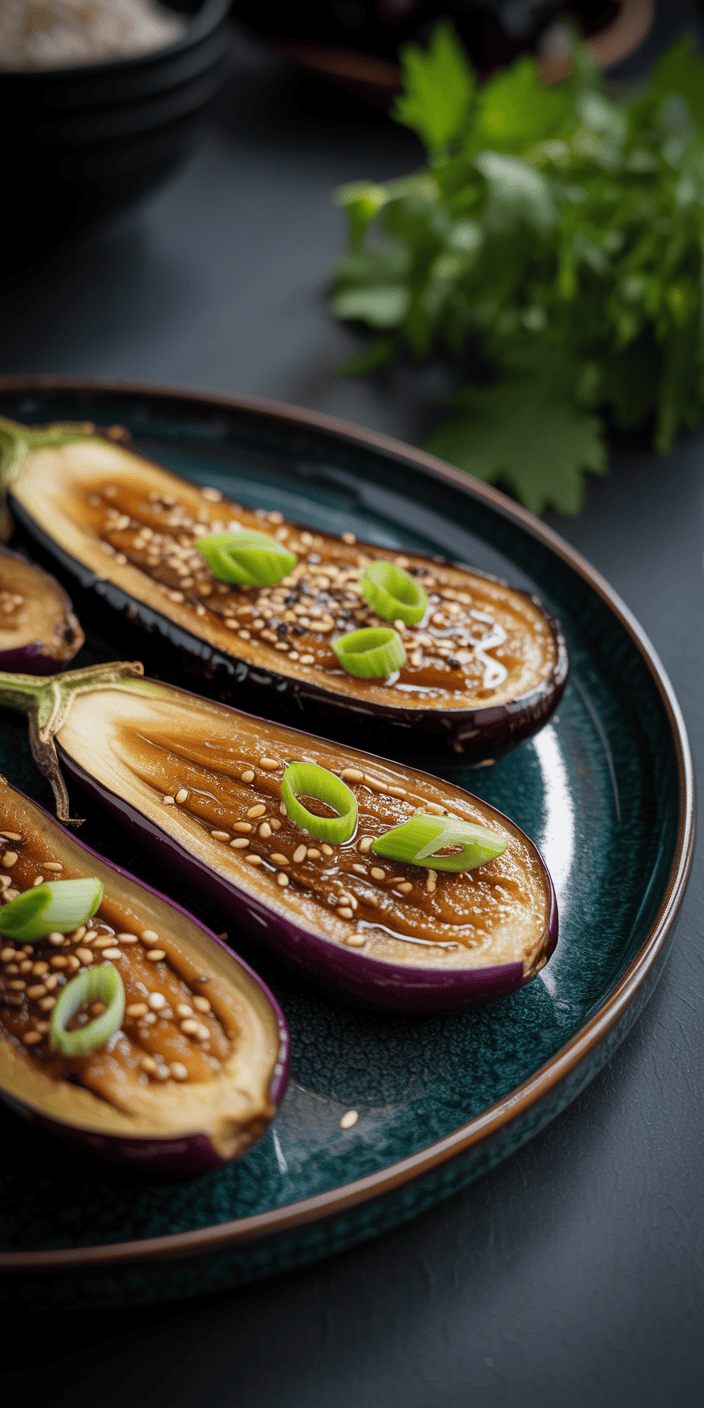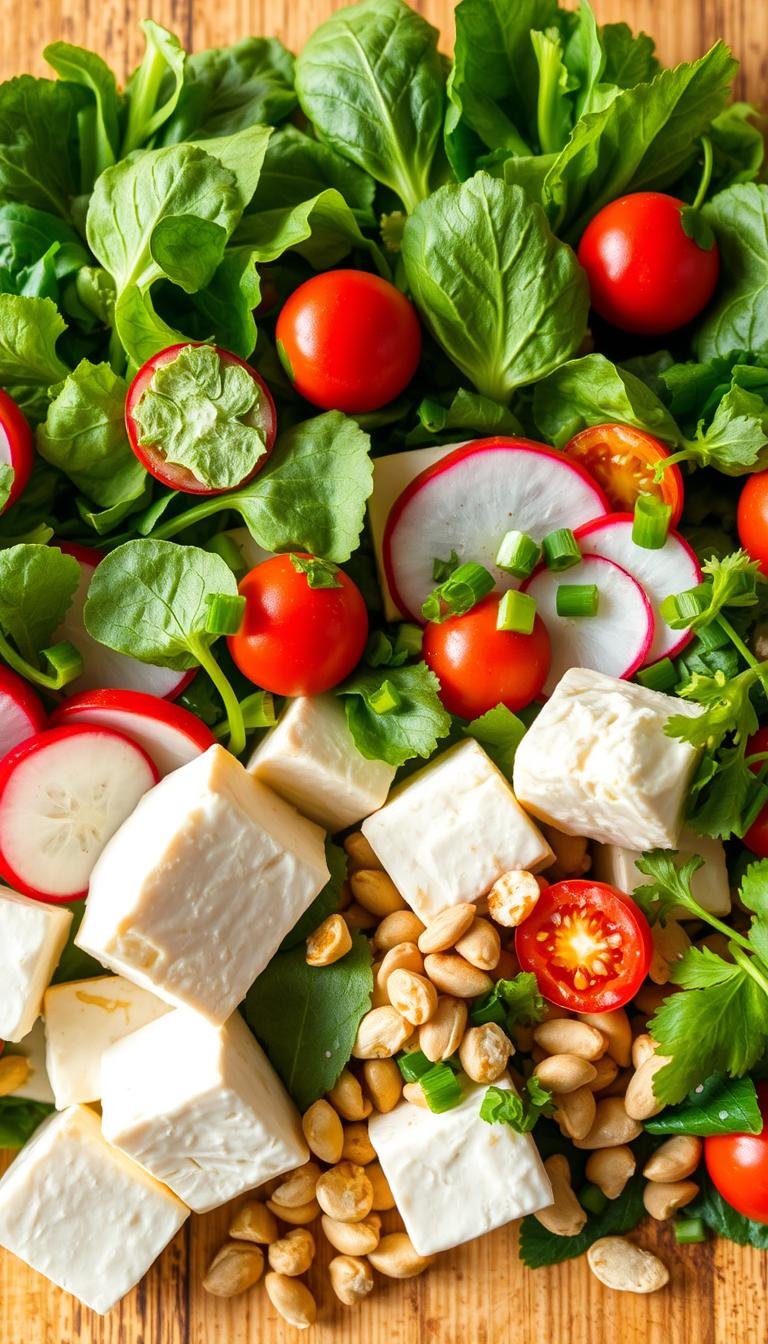Miso-Glazed Japanese Eggplant
Welcome to our delicious journey of preparing a mouthwatering Japanese eggplant recipe! This dish is a perfect blend of Asian flavors. It’s sure to impress your guests.
We’re excited to guide you through the simple steps to make this delicious recipe. You’ll learn about the cultural significance of Japanese eggplant. Plus, you’ll discover the secrets to creating the perfect miso glaze.
Key Takeaways
- Easy-to-follow steps for a delicious Japanese eggplant recipe
- Understanding the cultural significance of Japanese eggplant
- Tips for creating the perfect miso glaze
- Simple ingredients for a complex flavor profile
- A great recipe to impress your guests
The Art of Japanese Eggplant Dishes
Japanese eggplant is a key part of Japanese food, adding a special flavor and texture to dishes. It’s loved for its taste and cultural value, making it a favorite for centuries.
Cultural Significance in Japanese Cuisine
In Japan, eggplant is seen as a symbol of good luck and wealth. It’s a main ingredient in many Asian-inspired cooking recipes, showing Japan’s deep food culture. Japanese eggplant is used in many dishes, from simple grilled ones to complex simmered ones, proving its versatility and the creativity it sparks in cooks.
What Makes Japanese Eggplant Special
So, what makes Japanese eggplant unique? It has a delicate flavor and a soft texture, unlike other eggplants. This makes it perfect for vegetarian dishes, as it takes on flavors well without being too strong. Here are some key benefits:
- Less seeds and less bitterness
- Tender skin that’s easy to cook
- Versatile for various cooking methods – grilling, roasting, simmering
Whether you’re a seasoned chef or just starting out, Japanese eggplant is sure to spark your next dish!
Understanding Miso-Glazed Japanese Eggplant
Let’s explore the world of miso-glazed Japanese eggplant. It’s a dish that mixes the deep flavor of miso paste with the soft, sweet eggplant.
What is Miso Paste?
Miso paste is key in Japanese cooking. It’s made from fermented soybeans, salt, and koji (a fungus). It has a strong umami taste that enriches many dishes. Miso paste comes in types like white, yellow, and red miso, each with its own taste.
The Perfect Harmony of Flavors
The magic of miso-glazed Japanese eggplant is its flavor harmony. The savory miso pairs well with the eggplant’s natural sweetness. To get this balance, knowing how to use miso paste is key. Here’s a simple table to show the flavor balance:
| Ingredient | Flavor Profile | Role in Dish |
|---|---|---|
| Japanese Eggplant | Sweet, Tender | Main Ingredient |
| Miso Paste | Savory, Umami | Glaze |
| Sugar/Ginger | Sweet, Spicy | Enhances Flavor |
By mixing these elements, you get a dish with perfect flavor harmony.
Essential Ingredients for Miso-Glazed Japanese Eggplant
To make the best Miso-Glazed Japanese Eggplant, start with the right ingredients! The quality of your dish depends on choosing the finest components. This includes the eggplant, miso paste, and other supporting ingredients.
Selecting the Right Eggplant
When picking Japanese eggplant, choose ones that are firm and have a deep purple color. Stay away from eggplants with soft spots or those that are too large. They might be bitter. For grilling and roasting, smaller to medium-sized eggplants are best. They are less bitter and have fewer seeds.
Types of Miso for Glazing
Miso paste is key in Miso-Glazed Japanese Eggplant. There are white, yellow, and red miso paste types. White miso is sweeter and milder, while red miso is stronger and more savory. Mixing different types of miso paste can create a balanced flavor.
Supporting Ingredients and Substitutions
Other important ingredients include soy sauce, sake, mirin, and sugar for the glaze. Adding ginger and garlic can enhance the flavor. If you don’t have mirin, a sugar and vinegar mix can substitute it. For a vegan version, make sure your miso paste and soy sauce are vegan-friendly.
Kitchen Tools and Equipment You’ll Need
To cook Miso-Glazed Japanese Eggplant easily, you need some tools and equipment. Let’s prepare your kitchen!
Essential Tools
You’ll start with basic kitchen tools. A cutting board is key for eggplant prep. A sharp knife ensures even slices. You’ll also need a measuring cups and spoons set for precise ingredient measurements. A whisk is useful for mixing the miso glaze.
Optional but Helpful Equipment
Some equipment makes cooking easier, though not essential. A mandoline helps get thin eggplant slices. A silicone baking mat prevents sticking and eases cleanup. For frequent cooks, a good quality baking sheet ensures even heat.
Preparing Your Japanese Eggplant
Before we explore the tasty world of Miso-Glazed Japanese Eggplant, let’s cover the basics. Preparing your eggplant right is essential for a great dish.
Washing and Cutting Techniques
Washing your Japanese eggplant is a simple yet important step. Rinse it under cool water, then dry it with a clean towel. You can slice it into rounds or slabs, depending on your look. Make sure your cuts are even for even cooking.
Pre-cooking Treatments
To boost your eggplant’s flavor and texture, try some pre-cooking tricks. Salting is a classic method that removes moisture and bitterness. Sprinkle both sides with salt, wait 30 minutes, then rinse and dry.
Or, brush the eggplant with oil and grill or broil it briefly. This adds a smoky taste.
| Pre-cooking Treatment | Purpose | Method |
|---|---|---|
| Salting | Reduces bitterness, removes excess moisture | Sprinkle salt, let sit for 30 minutes, rinse, and pat dry |
| Grilling/Broiling | Adds smoky flavor, tenderizes | Brush with oil, grill or broil briefly |
Creating the Perfect Miso Glaze
The miso glaze is key to our Miso-Glazed Japanese Eggplant recipe. We’ve prepped our Japanese eggplant, now it’s time for the miso glaze. This glaze makes our dish go from simple to sublime.
Basic Miso Glaze Recipe
Our basic miso glaze recipe is a good start. You can tweak it to your liking. You’ll need miso paste, soy sauce, rice vinegar, and maple syrup. Add grated ginger and garlic for extra flavor.
Here’s a simple recipe: mix 2 tablespoons of miso paste with 1 tablespoon of soy sauce, 1 tablespoon of rice vinegar, and 1 tablespoon of maple syrup. Add 1 teaspoon of grated ginger and 1 minced garlic clove. Whisk until smooth!
Flavor Variations and Enhancements
Feel free to try different miso paste types or add ingredients for unique flavors. You can add sweetness with honey or spice with gochujang! Try adding fresh lime juice or sesame oil too.
“The art of cooking is not just about following a recipe, it’s about understanding the flavors and adjusting them to your taste.”
So, don’t be shy to experiment and make the miso glaze your own!
Make-Ahead and Storage Tips
You can make the miso glaze ahead of time and store it in the fridge for up to a week. Just stir it well before using. You can also freeze it for up to a month. Thaw it in the fridge or at room temperature when you’re ready to use it.
Step-by-Step Cooking Process for Miso-Glazed Japanese Eggplant
Let’s explore how to make Miso-Glazed Japanese Eggplant. This dish is both tasty and beautiful! We’ll cover preparing the eggplant, making the glaze, and cooking it using different methods.
Step1: Preparing the Eggplant
First, wash the Japanese eggplant well. Cut it into slices or halves. To lessen bitterness, sprinkle salt on the cut eggplant and wait 10 minutes. Then, rinse and dry it with paper towels.
Step2: Making the Glaze
To create the miso glaze, mix miso paste, soy sauce, sake (or dry white wine), and mirin in a saucepan. Whisk until it’s smooth and heat it over medium until it thickens. Stir constantly to avoid burning.
Step3: Applying the Glaze
When your eggplant is ready and the glaze is thickened, brush it evenly over the eggplant. Make sure it’s fully covered for the best flavor. You can glaze it again while cooking for more taste.
Step4: Cooking Methods
The way you cook your Miso-Glazed Japanese Eggplant can change its texture and taste. Here are three good ways to cook it:
- Broiling
- Grilling
- Baking
Broiling Method
Preheat your broiler. Place the glazed eggplant on a parchment-lined baking sheet. Broil for 5-7 minutes on each side until it’s tender and caramelized.
Grilling Method
Grilling gives the eggplant a smoky taste. Heat your grill to medium-high. Grill the eggplant for 5 minutes per side until it’s charred and cooked.
Baking Method
Baking is a healthier option. Preheat your oven to 400°F (200°C). Bake the eggplant for 20-25 minutes until it’s tender and glazed.
Each cooking method can make a delicious Miso-Glazed Japanese Eggplant dish. Try different ways to find your favorite!
Serving Suggestions and Presentation
Now that you’ve learned to make Miso-Glazed Japanese Eggplant, let’s focus on presentation. How you present your dish can greatly enhance the dining experience. It’s not just about the taste; it’s also about how it looks.
Traditional Garnishes
To add authenticity to your Miso-Glazed Japanese Eggplant, try using traditional Japanese garnishes. Some favorites include:
- Sesame seeds for added crunch and nutty flavor
- Shredded daikon radish for a burst of freshness
- Chopped scallions or thinly sliced green onions for a pop of color
- A sprinkle of grated yuzu zest for a hint of citrus
Plating for Visual Appeal
When plating, aim for a visually appealing arrangement. Here are some tips:
- Use a variety of colors and textures to add depth to your dish
- Balance your composition by arranging elements symmetrically or asymmetrically
- Don’t be afraid to add some height with garnishes or creative stacking
By using these serving suggestions and presentation ideas, you’ll elevate your Miso-Glazed Japanese Eggplant. You’ll impress your guests for sure!
Variations of Miso-Glazed Japanese Eggplant
Miso-Glazed Japanese Eggplant is super versatile. It’s great for adding your own twist, whether you like it spicy, sweet, or plant-based. It’s all about what you’re in the mood for.
Spicy Variation
Want a spicy kick? Add diced jalapeños or serrano peppers to the glaze. Or sprinkle red pepper flakes on top for more heat. It’s perfect for those who love a bit of spice.
Sweet and Savory Variation
For a sweeter version, mix honey or maple syrup into the glaze. The sweetness complements the savory miso, creating a tasty balance. Try adding caramelized onions on top for extra flavor.
Vegan and Dietary Adaptations
Miso-Glazed Japanese Eggplant is vegan-friendly. To make it gluten-free, use gluten-free miso paste. You can also try different eggplants or add veggies like bell peppers or zucchini. It’s a great way to mix things up!
These ideas show how versatile Miso-Glazed Japanese Eggplant can be. Don’t be afraid to try new things and find your favorite way to enjoy it!
Troubleshooting Common Issues
Even with the best recipe, things can go wrong. But don’t worry, we’ve got you covered! Making Miso-Glazed Japanese Eggplant can be a delightful experience. Sometimes, despite our best efforts, things don’t turn out as expected. Let’s dive into some common issues you might encounter and how to resolve them.
Preventing Bitter Eggplant
Bitterness in eggplant can be a turn-off. To prevent this, choose fresh, firm eggplants and properly salt and drain them before cooking. This simple step can make a big difference in the flavor!
- Select eggplants that are heavy for their size
- Slice or cut the eggplant, then salt liberally
- Let it sit for 30 minutes before rinsing and cooking
Fixing Texture Problems
If your eggplant turns out too soggy or too firm, don’t worry, we’ve got a fix! For a softer texture, try roasting or grilling the eggplant. If it’s too soft, perhaps it was overcooked – try reducing the cooking time or using a firmer variety.
Balancing Flavors in the Glaze
The glaze is where the magic happens, but sometimes it can be too sweet, too salty, or too bland. To balance the flavors, adjust the amount of miso paste, add a squeeze of fresh citrus, or a drizzle of honey. Taste as you go and adjust according!
Conclusion
Now that you’ve reached the end of our Miso-Glazed Japanese Eggplant recipe guide, it’s time to put your new skills to the test! We hope you’ve enjoyed learning about this delicious dish. You’re probably excited to try out different variations and ingredients.
As a final tip, remember that the key to mastering this recipe lies in balancing the flavors and textures. Don’t be afraid to try new combinations and adjust the glaze to your taste. With practice, you’ll be creating mouth-watering Miso-Glazed Japanese Eggplant that’s sure to impress your family and friends!
We’d love to hear about your experiences and any creative twists you come up with. Happy cooking, and we look forward to sharing more simple yet impressive recipes with you in the future!







